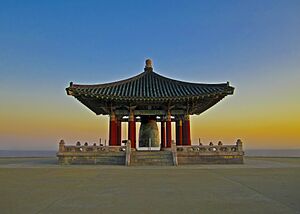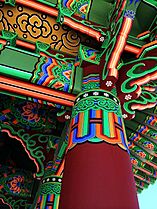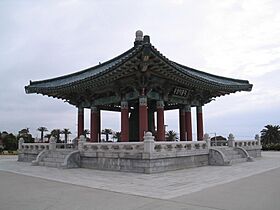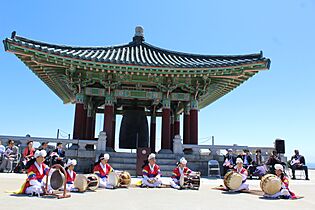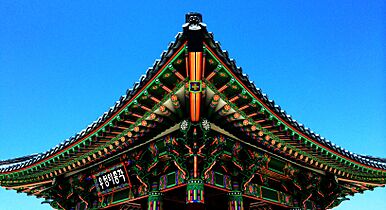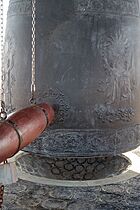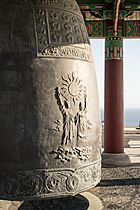Korean Bell of Friendship facts for kids
| Korean Bell of Friendship | |
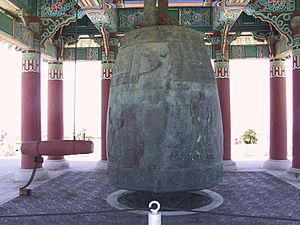 |
|
Quick facts for kids Korean name |
|
|---|---|
| Hangul |
우정의 종
|
| Hanja |
友情의 鐘
|
| Revised Romanization | Ujeong-ui Jong |
| McCune–Reischauer | Ujŏng'ŭi Chong |
| Designated: | May 3, 1978 |
| Reference #: | 187 |
The Korean Bell of Friendship is a giant bronze bell. You can find it inside a stone building in Angel's Gate Park. This park is in the San Pedro area of Los Angeles, California. This part of the park is also called the "Korean–American Peace Park." It sits on land that used to be part of Fort MacArthur.
Contents
About the Bell
The Korean Friendship Bell looks like another famous bell. It is modeled after the Divine Bell of King Seongdeok the Great of Silla. This ancient bell is also known as the Emille Bell. The Emille Bell was made in the year 771. It is now kept at the National Museum of Gyeongju in Korea.
The Emille Bell is a very important piece of history. It was named a National Treasure of Korea in 1962. It is the biggest bell ever made in Korean history. Both the Emille Bell and the Korean Friendship Bell are among the largest bells in the world.
What the Bell is Made Of
This amazing bell weighs over seventeen tons. It is mostly made of copper and tin. Other metals like gold, nickel, lead, and phosphorus were added. These extra metals help give the bell its beautiful sound.
The bell is about 7.25 m (23.8 ft) around. It is about 3.63 m (12 ft) tall. Its sides are about 8 in (200 mm) thick.
Bell Decorations
The outside of the bell is covered with detailed pictures. These pictures are carved in a style called relief. There are four pairs of figures on the bell. Each pair has a "Goddess of Liberty." She looks a bit like the Statue of Liberty.
Next to her is a Seonnyeo, which is a Korean spirit figure. These figures hold symbols of South Korea. You can see the Taegeuk symbol, a branch of rose of Sharon, a branch of laurel, and a dove.
Bell's History and Purpose
The government of South Korea gave this bell to the United States. This gift was to celebrate America's 200th birthday. It also showed the strong friendship between the two countries. A Korean American actor named Philip Ahn helped make this happen.
The bell was officially presented on October 3, 1976. It was later named a Los Angeles Historic-Cultural Monument on May 3, 1978.
When the Bell Rings
The bell does not have a clapper inside. Instead, a large wooden log is used to strike it. The bell is usually struck 13 times. This happens on the first Saturday of every month at 11:30 AM.
Since 2010, the bell has also been rung on five special days each year:
- December 31: New Year's Eve
- January 13: Korean American Day
- July 4: Fourth of July
- August 15: Korean Liberation Day
- September 17: Constitution Day
The bell was also rung on September 11, 2002. This was to remember the events of September 11, 2001.
The Bell's Home
The building that holds the bell is called the Belfry of Friendship. Skilled craftsmen from South Korea built it. It took them ten months to finish. The building has a traditional Korean design.
It has a pyramid-shaped roof. Twelve columns support this roof. Each column stands for an animal from the Korean zodiac. Each column also has a carved animal guardian. The colorful patterns on the building are called dancheong in Korean.
Bell Restoration
In 2013, the bell was fully cleaned and repaired. Workers removed rust and graffiti. The area around the bell was closed from September to December. The City of Los Angeles held a ceremony on January 10, 2014. This was to celebrate the bell's return.
The Korean Ministry of Culture, Sports and Tourism helped pay for the repairs. They gave more than US$300,000 (equivalent to $371,000 in 2022) to hire experts for the restoration. The bell was closed again for over a year. This was due to the COVID-19 pandemic in Los Angeles. It reopened in May 2021.
Images for kids
-
Korean Liberation Day ceremonies (2019)
See also
 In Spanish: Campana Coreana de la Amistad para niños
In Spanish: Campana Coreana de la Amistad para niños
- History of the Korean Americans in Los Angeles
- Koreatown, Los Angeles
- List of Los Angeles Historic-Cultural Monuments in the Harbor area


